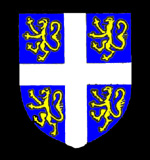
The Dakeney family coat of arms
The de Albini family held the Manor of Clophill, of five hides, and the Manor of Cainhoe, of four hides at the time of Domesday Book in 1086. They also held land in Ampthill (5 hides), Arlesey (3 virgates), Broom (5 hides), Carlton (2 hides and a third and half a virgate), Clifton (2 hides), Harlington (5 hides), Harrowden (6 hides), Henlow (5½ hides), Holme (Biggleswade - 1 hide, ½ virgate), Husborne Crawley (6 hides), Marston Moretaine (8 hides, ½ virgate), Marston Shelton (1½ hides), Maulden (25 acres), Millbrook (5 hides), Milton Ernest (3 hides less 1 virgate), Priestley (in Flitwick - 1½ hides), Pulloxhill (10 hides), Radwell (7 hides, 1½ virgates), Silsoe (2 hides), Streatley (4 hides and a third) Tingrith (2 hides, 1 virgate), Turvey (1½ hides), Westcotts (in Wilshamstead - 3 hides less 1 virgate) and Wyboston (9 hides, 1 virgate). The family also held parts of half a hide in the Biggleswade Hundred as well as in parts of Buckinghamshire, Leicestershire and Warwickshire. The whole barony was held from the king for the service of twenty five knights, to be provided to the royal army on demand.
The barony remained in the de Albini family until 1233 when Robert, the last male heir died and the barony was divided between his three sisters. One of these, Joan, wife of Geoffrey de Beauchamp, died without issue. The other two sisters, Isabel, wife of William de Hocton and Azelina, wife of Aimery de Saint-Amand. The Saint-Amand family became extinct with the death of the last male heir in 1402. The eventual heiress, Elizabeth Braybrook, married Sir William Beauchamp in 1449 and the Saint-Amand barony was revived for him but in 1441 the Beauchamps had sold their half of the barony to Sir John Cornwall who was then created Baron Millbrook.
Cainhoe Castle was included in the half of the manor given to Isabel de Hocton. Her second husband was Drew des Preaux. Her son William must have assumed the name de Albini as he is known by that name when he succeeded his mother in 1262. His son Simon died in 1272 and this half of barony was then divided between his three sisters Isabel, Christina and Joan.
The youngest sister, Joan married three times and by her second husband Sir Roger Dakeney left a son, Robert, to whom her sixth share of the barony descended after her death in 1310. He died in 1316. He later acquired a further ninth of the manor.
Isabel married Hugh de Saint-Croix and later William de Hotot. Her son Peter de Saint-Croix succeeded and died, along with his son, perhaps of the Black Death in 1349 (the year it first entered England). His second son Thomas inherited and in 1362 alienated his sixth of the barony to Sir John Cheyne, with a remainder to John Dakeney.
The sixth of the barony which went to Christina was divided into further thirds (eighteenths of the whole manor) on her death in 1318, going to her three daughters by Peter de la Stane - Elizabeth, Margery and Christina. Christina married Anthony de Byddik and died in 1326 and she was succeeded by her son John de Mere, who granted it to John Dakeney for life in 1334, John acquiring full possession in 1336. Elizabeth's son Peter de Norton inherited her part of the barony and, on his death, his brother Thomas received it, but alienated it to John Dakeney in 1334. It then reverted to Thomas' son and he sold it to John Dakeney in 1373. Margery's son Brian Saffey inherited her share but died, probably of Black Death, in 1349. His uncle Thomas Saffey then succeeded to it and it passed to his sister Joan in 1361 and she, in 1364, alienated it to John Dakeney.
When he purchased Elizabeth de la Stane's share of the manor in 1373 John Dakeney thus gained possession of Isabel's original half share. Ironically, he died three years later and his son died as a minor in 1384, his half of the barony passing out of the family, to John's sister Alice, wife of Walter Alnthorpe. Between 1415 and 1428 the half barony was alienated to Reginald de Grey and remained in this family until Richard de Grey, earl of Kent, sold it to Giles, Lord Daubeny some time during the reign of Henry VII (1485-1509). The Victoria County History states that Lord Daubeny's son probably sold his half of the barony to Sir William Compton and, on his death, in 1528 it reverted to the Crown under the terms of Sir William's will.